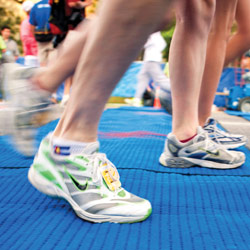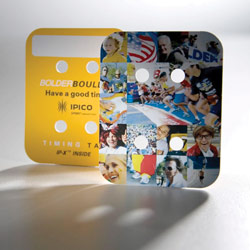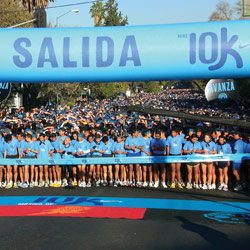
IPICO Sports is shaking up the world of sports technology, one runner at a time.
Philip Lockwood has taken Nike’s popular slogan, “Just Do It,” and run with it. The longtime technology strategist melded his eye for innovation with a passion for running when he founded the Mercury Sports Group (MSG) in May 2003. His goal: to revolutionize the way distance races are timed by creating an easy-to-use device for tracking runners’ times. Lockwood, who has directed the Steamboat Classic and Race for the Cure for nearly two decades, had a personal motivation to make his life at such events a little easier. Combining his passions allowed for a remarkable opportunity to grow as a pioneer in the field of sports technology.
In November 2008, Peoria-based MSG was acquired by Canadian-based RFID technology developer IPICO Inc. and launched IPICO Sports to develop and market sports applications at professional, collegiate, scholastic and amateur events. Lockwood now serves as vice president and chief technology officer of IPICO Sports.
As both a runner and event manager, Lockwood understood firsthand the difficulties in timing athletes at sporting events. The old model—contracting an outside company to time the event, sans digital capturing devices or a centralized database—can be a headache to track hundreds of runners at a single event. A mechanism was needed to improve the ease and transmission of data capture, as well as provide runners and spectators with more information during the race.
Under the traditional method of timing races, it’s difficult—if not impossible—for an observer to accurately track the performance of a specific athlete or team, relative to other participants. The lack of information can be equally frustrating for the runner seeking reliable split times. Enter IPICO Sports, which uses Radio Frequency Identification (RFID) to capture information at periodic intervals and relay it to participants, coaches, media and fans during the race. For example, at the 2008 Illinois High School Association (IHSA) State Cross-Country meet, timing systems were in place at the one, 1.5 and two-mile marks to track individual and team progress.
This state-of-the-art technology was not initially developed for sports applications. “We started with an exhaustive search of RFID technology, which had been around for many years,” says Lockwood. “We found that many lines converged in South Africa, which is also where IPICO Inc. was formed.”
The South African government was using RFID for guidance systems as part of its national defense. IPICO Inc., an intellectual property and innovation company, was a small group at the core of the government research center and was looking for partners to take its technologies to the global market.
“They had a unique RFID solution that lends itself well to objects that are high in liquid, carbon and electronic content, all characteristics of the human body,” explains Lockwood. “With that in mind, we started working with IPICO engineers to define a product for active sports applications.”
In December 2003, the first IPICO Sports timekeeping prototypes were introduced to the world. Seven months had passed since Lockwood had officially founded MSG, and more than two years since he decided to meld his private and professional passions with the goal of shaking up sports technology.
Meet the Reader
RFID is primarily used for supply-chain management and asset-tracking applications. In other words: inventory. For the purpose of tracking boxes in a warehouse, it is easy to identify entrance and exit points for packages containing RFID tags. “However,” explains Lockwood, “the difficulty to accurately measure goods increases dramatically when the inventory is mobile. At an event, IPICO Sports equipment must be capable of handling a starting line up to 60 feet wide, often with several thousand runners crossing it.
 “You begin to deal with large densities of tags in the field at one time,” continues Lockwood, “and several different things (from the weather to electronic devices) can create electrical noise that has the potential to interfere. It’s difficult to test for all of those conditions.”
“You begin to deal with large densities of tags in the field at one time,” continues Lockwood, “and several different things (from the weather to electronic devices) can create electrical noise that has the potential to interfere. It’s difficult to test for all of those conditions.”
Lockwood gave his equipment its first trial run at the 2005 Steamboat Classic. It wasn’t quite deemed market-ready at the time, but the company wanted to evaluate system performance in a real race environment. In 2007, he finally had a product that met his standards.
The Elite Reader is an unassuming box about 18 inches wide, 12 inches deep, and 14 inches tall, enclosed in a durable metal shell case. The device produces two carrier frequencies. One is used as a radio transmitter to “turn on” small RFID tags worn by the race participants. The other acts as a receiver to capture the information returned by the RFID tag. These frequencies are delivered by separate antennas embedded in mats laid across the surface of the course.
The RFID tags each contain a unique number that it broadcasts each time the tag crosses an antenna mat. That data is processed by the reader, matched with a timestamp and filtered through custom software to provide usable information that is then relayed to participants and spectators. The tag can be attached to shoelaces, or mounted on an ankle strap or bike mount.. This flexible design allows for tracking of foot races, as well as skiing, cycling and multi-sport events. IPICO software has also been adapted to work with photo-capturing devices commonly used for video backup, in addition to improving the overall accuracy of results.
The first Elite Reader shipped in March 2007. Since then, IPICO Sports has delivered 235 Elite Readers around the world at a selling price of $12,500. Further market study led to the development of a basic entry-level version, the Lite Reader. More than 140 units at $5,500 each have been shipped since it launched in May 2008. The readers are not inexpensive, but the company is committed to keeping them cost-competitive compared to other timing equipment suppliers.
“We shook the market up when we went to production,” says Lockwood, noting that the company attracted some significant customers who converted from a primary competitor. The competing company was giving their customers a case of what Lockwood described as “sticker and complexity shock.” Since then, additional competitors have entered the market, both domestic and abroad. The competition has forced IPICO Sports to carefully guard its patents. “Many have bought into our business model,” says Lockwood. “We’ve definitely created a paradigm shift.”
Staying close to its roots, IPICO Sports sees running clubs as a primary focus. One of their largest customers is a club in San Paolo, Brazil with over 9,000 members. The group transitioned from hiring an outside company for event timing to self-managed timing using IPICO Sports readers. Like many of its customers, the group purchased an initial package suitable for its needs and continues to buy additional equipment as their demand and expertise increases. This model has become standard, providing a sustainable revenue stream while continuing to support customers that were previously unable to time their own events.
“Our three guiding principles are ease of use, ease of ownership, and superior technology. That goes into everything we do from a hardware standpoint, software and communication tools, and business practices,” states Lockwood. “We really are a knowledge-capital-intensive company, and for us, it’s about building that knowledge capital base.”
No False Start
IPICO Sports currently employs 10 people, including nine in the Peoria area. In hiring, they seek applicants with a technical background and/or relationships in the broad marketplace. It was the latter category that was of particular importance in growing the start-up company.
“You can come along with the greatest next-generation mouse trap, but if you don’t have the relationships within that industry, the road ahead can be very bumpy,” says Lockwood. “The benefit we had is that each of us involved [in the founding of the company] was established in the trade and knew influential people that we could draw upon for advice and direction. They were also potential customers.”
Lockwood points to his connections to the Chicago and London Marathons, two of the most prestigious events in the world, as well as his organization of local events and involvement with Bradley University and the IHSA. These relationships provided him with a strong Rolodex to complement his technological know-how.
Lockwood has worked in the technology sector since graduating from Bradley in 1985 with an engineering degree. In 1996, he left Caterpillar to work as a volunteer at the 1996 Summer Olympics in Atlanta. He then did various assignments as a consultant and strategic planner responsible for the development and implementation of new technologies. It was his hobby of running and race coordination, however, which led to his philosophy: follow what you love to find work that motivates you.
“We were very lucky that our genesis came about almost the same time as Peoria NEXT. There were people within Peoria NEXT looking for projects to launch. We also received support from the Heartland Partnership and ITEC [Bradley Technology Commercialization Center],” says Lockwood. “We got a great deal of support—especially from some of the people within Peoria NEXT, who were really helpful in guiding us through the maze.”
Lockwood specifically credits Tarsem Jutla, a Caterpillar employee who was instrumental in the founding of Peoria NEXT. “He really understood what I was pursuing [in the formation of MSG],” adds Lockwood, “and how it related to the mission of Peoria NEXT.” Lockwood also sites Bradley’s Turner Center for Entrepreneurship and Jim Foley, director of its International Trade Center, who provided guidance on global trade issues.
“We were lucky that all these resources to help new businesses were here in central Illinois. You actually can create and operate an international business out of Peoria,” concludes Lockwood. His own company is proof of that.

In addition, Peoria NEXT was helpful in assembling audiences who were open to listening to Lockwood’s pitch. This led to many angel investors joining forces to capitalize a high-risk, technology start-up. Some of those investors provided a significant amount of intellectual resources as well. They were essential in helping Lockwood ask the right questions pertaining to his business plan and go-to-market strategy.
Catching a Second Wind
IPICO Sports now finds its revenue exceeding the company “burn rate.” Its revenue has nearly doubled from $1.6 million in 2007 to a little over $3 million in 2008, with sales forecasts in excess of $6 million in 2009.
In spite of the current economic downturn, Lockwood remains optimistic. The last great boom in the running industry came in 1982 and ’83, when the country was suffering from the effects of a recession. He finds inspiration in recalling that history, saying, “During times of economic uncertainty, people are looking for something over which they can exert control—like their health.”
“Exercise is so powerful with respect to how it helps people control stress,” says Lockwood. “It is one of the most potent ‘drugs’ there is for dealing with heart disease, early-onset diabetes, hormonal-based cancers and many other health-related issues. Activities like running take a minimal investment and become a positive addiction because of the health benefits, as well as the social aspect and fun with event participation.”
Later in 2009, IPICO Sports will launch its products to the scholastic world. Partnerships are already in place to market to this sector. A beta program has been introduced at a school in Maryland to grade performance and improvement in mile-run times using IPICO Sports custom software.
Lockwood also sees his company’s products gaining traction through park districts and running communities, in addition to organized events. “Our initial focus was delivering tools on an organizational level to event directors. The second step, as we move forward, is to reach a broader market. One of the things we are developing is the ability to install fixed placement of the technology. For example, an option may be installing systems on the path along the riverfront. Imagine showing up at the RiverPlex to go for your run or walk and when you return, it’s all been recorded,” explains Lockwood. “You could then go online and track results without having to download data from a watch or GPS, and there would be no need to fill out a training log. It would all be done for you.”
Other applications in the future focus on enhancing the data accumulation. This includes mapping topography against timing points to see splits compared to terrain. “The range of data—from heart rate to stride frequency—that could be collected in the future would also provide a significant portrait of one’s activity,” according to Lockwood. This is valuable information for a person, but also for healthcare providers and insurance companies.
Thus, a transition is on the horizon for IPICO Sports as they find other opportunities in personal wellness activities and consumer applications, in addition to competitive sports. In fact, when it comes to personal wellness, Lockwood is eager to set the standard in his professional and personal life. “Our own running, cycling or other events have taken a back seat to getting the business going,” Lockwood says of himself and his staff. “Now it’s time to get back into shape.” iBi

